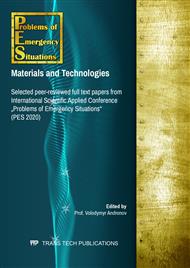[1]
Yu.A. Mihaylin. Konstruktsionnyie polimernyie kompozitsionnyie materialyi, Nauchnyie osnovyi i tehnologii., M, (2008).
Google Scholar
[2]
M. L. Kerber., V.M. Vinogradov,; G.S. Golovkin, Pod red. A.A. Berlina, Polimernyie kompozitsionnyie materialyi: struktura, svoystva, tehnologiya: Uch. pos., 3 izd., ispr., Professiya, Sankt-Peterburg, (2011).
Google Scholar
[3]
Tobisawa Akihiko, Honjoya Tomoyoshi, Sumitomo Bakelite Co., Ltd, Flame-retardant resin composition and prepreg and laminate using the same, U.S. Patent 6486242 (2002).
Google Scholar
[4]
Hwang Kuen-Yuan, Chen Hong-Hsing, Chen Chih-Fu, Chang Chung Plastics Co., Ltd., Phosphorous-containing flame retardant epoxy resin and an epoxy resin composition containing the same, U.S. Patent 6576690 (2003).
Google Scholar
[5]
Dean Jennifer M., Bates Frank S., Pham Ha Q., Verghese Nikhil E., Dow Global Technologies Inc., Regents of the Univ. of Minnesota, Curable flame retardant epoxy compositions, U.S. Patent 6887574 (2005).
Google Scholar
[6]
A.A. Berlin, Goreniya polimerov i polimernyie materialyi ponizhennoy goryuchesti. Plasticheskie massyi, 9 (1996) 57-63.
Google Scholar
[7]
A.A. Berlin, A.S. Fialkov, G.I. Tsvelihovskiy, Karbonizatsiya fenolo-formaldegidnyih smol rezolnogo tipa, Plasticheskie massyi, 3 (1965) 44-47.
Google Scholar
[8]
P.A. Bilyim, A.P. Mihaylyuk, K.A. Afanasenko, Issledovanie poristosti, pronitsaemosti i strukturyi koksovyih ostatkov poliepoksidnyih svyazuyuschih, Problemyi pozharnoy bezopasnosti: Sb. nauch. tr. 23 (2008) 48-56.
Google Scholar
[9]
K.A. Afanasenko, P.A. Bilyim, A.P. Mihaylyuk, K voprosu o karbonizatsii i potere massyi setchatyih poliepoksidov pri lineynom nagreve, Problemyi pozharnoy bezopasnosti: Sb. nauch. tr. 33 (2013) 13-17.
Google Scholar
[10]
P.A. Bilyim, A.P. Mihaylyuk, K.A. Afanasenko, Predelnyie skorosti goreniya i vyigoraniya stekloplastikov na osnove koksuyuschihsya svyazuyuschih, Problemyi pozharnoy bezopasnosti: Sb. nauch. tr. 23 (2008) 40-47.
Google Scholar
[11]
GOST 12.1.044-89* (ISO 4589-84), Sistema standartov bezopasnosti truda (SSBT). Pozharovzryivoopasnost veschestv i materialov. Nomenklatura pokazateley i metodyi ih opredeleniya.
Google Scholar


